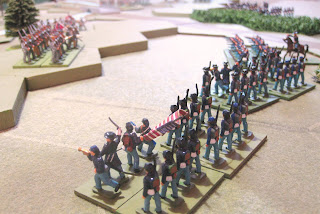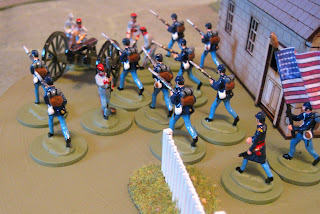Many have observed the similarity of this game to the demonstration game set in the Plattville Valley by Donald Featherstone. Those observations were correct. I was going to refight this battle, however, given the size of my table I had to adapt it somewhat. Also, the troop levels were completely different.
All that said, the battle kicked off just after lunch, both sides having deployed on to the high ground on each side of the river. The CSA forces decided their position was strong enough to defend, while Federal General Smith realised he was going to have to assault and force the rebels off Mole Hill and the features dominating the bridge over the river.
The Federal plan was to attack on the left across the bridge to fix the rebels and try to draw off the resrves and put in the main attack on the right flank against Mole Hill and its farm.
The action began with the Iowa Regiment rushing the bridge in the face of artillery fire and musketry from the Texans. They got off lightly, only losing one figure, while Union battery 3 engaged the rebel guns taking out a gunner:
The Iowa Regiment made it to the fence line OK and attempted to shake out into a firing line:
But, now they were in range of the Texas veterans who poured volleys across the wheat field, as did the rebel gun:
The Iowa's colonel fell and their morale broke causing them to rout back over the bridge, where they were decimated by fire from the Alabama Regiment on Warren Ridge. Their rout continued off the table despite an attempt by General Reeves to rally them:
The Federal attack on the left had failed and action was reduced to an exchange of fire over the river between the Alabama Regiment and the New Jersey boys, that caused casualties on both sides.
Federal General Smith, decided that further attacks on the left would be futile and he sent orders for Parson's Brigade to take Mole Hill. This action began with the Federal Sharpshooters advancing towards the corn patch where they ran into the Mississippi Sharpshooters. A brisk fire fight developed between the two groups of skirmishers. Initially the Federal sharpshooters were forced back after taking light casualties:
However, having rallied the Federal skirmishers saw off the Mississippi Sharpshooters, who doubled away to the rear past the Kentucky Regiment::
The Federals now concentrated their fire on the Georgia Regiment holed up in Mole Hill farm and the combination of musket, skirmish and artillery fire caused several casualties:
Meanwhile, having been tangled up amongst the snake fences around the Wheatfield, Parson's brigade shook out and began its move towards Mole Hill:
Taking some fire from the Georgians, the new Yorkers and Illinois Regiment pushed on. With a final charge, the Illinois Regiment stormed into the farm and a furious melee ensued:
Realising that the Georgians in the farm were in danger of being overun, CSA General Johnson orders the Kentucky Regiment to advance, while he heads off to shore up the defences of Mole Hill.
Unfortunately for Johnson, the Georgians are all but wiped out and the farm falls to the Illinois Regiment, who continue their rampage by charging into CSA Battery A, wiping that out too. In the Melee General Johnson is pulled from his horse and dies:
The collapse of the Rebel left begins. With the loss of General Johnson, the Georgians and the artillery, the Kentucky Regiment must take a morale test. They fail and rout from the field.
On the other side of the field the New Jersey Regiment on Twin Buttes continues its exchange of fire with the Alabama Regiment, eventually forcing the latter back off Warren Ridge:
At the same time Federal artillery Battery 3 scores a direct hit on CSA Battery C, wiping out the crew:
With the demise of the CSA gunners, the Vermont cavalry decide to make a charge across the river bridge:
This is a mistake as they run into a hail of fire from the Texans, losing nearly half their number. However, this small victory cannot save the CSA army and General Spencer gives the order for a withdrawal, covered by the Texans and Virginia cavalry. The battle is over leaving the Federals in control of the field, but they are exhausted and unable to pursue.
For this game I used Featherstone's rules. I found that they could be very cruel when it came to a firefight, especially when followed by poor morale. Infantry volleys are devastating when they hit home. That said, this was a fun game and an excellent way to give these lovely old soldiers a try out. It was certainly enjoyable and spectacular. I think the Texans deserve a battle honour for this one!


























































